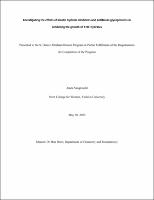Please use this identifier to cite or link to this item:
https://hdl.handle.net/20.500.12202/8259| Title: | Investigating the effects of kinetic hydrate inhibitors and antifreeze glycoproteins in inhibiting the growth of THF hydrates |
| Authors: | Drori, Ron Neugroschl, Atara |
| Keywords: | kinetic hydrate inhibitors antifreeze glycoproteins THF hydrates |
| Issue Date: | 20-May-2022 |
| Publisher: | Yeshiva University |
| Citation: | Neugroschl, A. (2022, May 20). Investigating the effects of kinetic hydrate inhibitors and antifreeze glycoproteins in inhibiting the growth of THF hydrates. Undergraduate honors thesis, Yeshiva Univerisity. |
| Series/Report no.: | S. Daniel Abraham Honors Student Theses;May 20, 2022 |
| Abstract: | When examining the inhibition effect of PVP, there is a clear correlation between the molecular weight and TH activity, as with increased polymer size, the inhibition increases. This correlation is likely due to the proposed mechanism of inhibition of KHIs that includes binding of the compound to the hydrates surface. The larger polymers cover a greater surface area and are therefore more effective at inhibition. However, the efficacy of PVP seems to plateau at a higher polymer length. PVP360, has a higher TH activity than PVP40, but the gap is not proportionate to the increased size of PVP360. PVP360 is 9 times as larger compared to PVP40, with 320 more monomer units, however the activity is only slightly higher. This could indicate that after a certain length, additional monomer units do not affect the efficacy of the inhibitor.¶ ZRAH, which has never been proven to inhibit THF hydrates, had clear inhibition capabilities. While the inhibition activity was low, ZRAH values were comparable to AFGP8, which inhibits ice growth much more effectively compared to ZRAH. The limited activity could be due to the low molecular weight of ZRAH, and the possibility that ZRAH assembles in solution and forms self-assembled structures before binding to the crystal surface.¶ The AFGPs appear to inhibit THF hydrates in a similar manner as they inhibit ice growth. For ice, AFGP1-5 has stronger inhibition than the smaller AFGP8 and the same pattern was observed here with THF hydrates. Specifically, I hypothesize that the proteins adsorb to the surface of the hydrates, as they adsorb to ice surfaces and this binding event inhibits further growth. This is also supported by the fluorescence surrounding the crystal structure which would indicate that the proteins are adhering to the crystal’s surface (Fig. 17).¶ In summary, these results provide strong evidence that the inhibition of THF hydrates by synthetic and biological KHIs is dictated by the molecular weight of the KHIs. The larger AFGP1-5 is a slightly better inhibitor than PVP at comparable molecular weights. This is an important insight, as AFGPs probably bind to ice and THF hydrates via their disaccharide moiety, while PVP’s γ-lactam ring fills empty cages on the surface of the hydrate. (from Discussion) |
| Description: | Undergraduate honors thesis / Open Access |
| URI: | https://hdl.handle.net/20.500.12202/8259 |
| Appears in Collections: | S. Daniel Abraham Honors Student Theses |
Files in This Item:
| File | Description | Size | Format | |
|---|---|---|---|---|
| Atara Neugroschl OA Thesis May2022.pdf | 679.36 kB | Adobe PDF |  View/Open |
This item is licensed under a Creative Commons License

